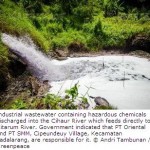A recent report of the Global Humanitarian Forum estimates that per year climate change already causes 300,000 deaths throughout the world, seriously impacts on the lives of 325 million people, and costs USD 125 billion globally [13]. As a result of climate change, many countries may already be able to show a certain degree of harm – whether this is the loss of territory, crops or biodiversity.
However, according to the majority opinion amongst writers, the actual occurrence of harm is not a precondition for a violation of the no-harm rule. It is sufficient to show that a State’s conduct will cause significant damage for its responsibility to be engaged [14]. Thus, the no-harm rule is not only a general obligation to prevent trans-boundary harm, but also to minimize the risk of such harm [15].
In much of the literature, the precise scope and features of the no-harm rule has been defined by reference to the requirement of due diligence. Due diligence is said to comprise at least the following elements: the opportunity to act or prevent; foreseeability or knowledge that a certain activity could lead to trans-boundary damage; and proportionality in the choice of measures required to prevent harm or minimize risk. If, despite the foreseeability of events, proportionate measures which are capable of protecting the environment of other States were not taken, a State can be considered careless and held responsible for a wrongful act [16].
Many developed countries have had an opportunity to reduce the risk of trans-boundary pollution by limiting their emissions of greenhouse gases (GHG) through, for example, stricter regulations and control measures, the introduction of renewable energies or changes in lifestyle of their populations. They have known of the effects of increasing atmospheric concentration of CO2 on the earth’s heat balance and the subsequent risk of damage for decades. At least since 1992, when the UNFCCC was put in place to stabilize greenhouse gas emissions, parties to that agreement have explicitly acknowledged this link.
b) The Resulting Liability
A State can only be held responsible for the breach of an international obligation if this can be attributed to an act or omission of one (or more) of its organs. In most industrialized countries, the majority of GHG emissions have been generated by private entities. In international relations, however, a State remains accountable for activities on its territory and under its effective control [17]. By approving activities that result in GHG emissions, or by failing to put restrictions into place that prevent harm to other countries, governments are responsible for the resulting trans-boundary pollution and non-compliance with the no-harm rule.
To date, the discourse in the academic literature on State responsibility for climate change has very much focused on the question of compensation for damages. However, if the responsibility of a State for an unlawful act under international law has been established, the primary obligation that arises is to cease the wrongful act. Depending on the context, this could mean the unconditional withdrawal of troops and abstention from any further military action, the immediate release of hostages and prisoners, ending existing discriminations or disturbances to the internal order of a country, or taking necessary measures to prevent the destruction or theft of property [18].

On 31 March 2008, Ecuador filed a dispute at the International Court of Justice (ICJ) concerning the aerial spraying by Colombia of toxic herbicides at locations near, at, and across its border with Ecuador. Ecuador alleged that the spraying causes serious damage to people, crops, animals and the natural environment on the Ecuadorian side of the border, and poses a grave risk of further damage over time. Amongst other things, Ecuador requested that the Court declare that Colombia has violated its obligations under international law and shall “…take all steps necessary to prevent, on any part of its territory, the use of any toxic herbicides in such a way that they could be deposited onto the territory of Ecuador; and (iii) prohibit the use, by means of aerial dispersion, of such herbicides in Ecuador, or on or near any part of its border with Ecuador” [19].
In order to raise a claim of State responsibility, it is further necessary to establish that there is a causal link between the activities complained of and the harm in question. In 2007, the International Panel on Climate Change (IPCC) found that there is a better than nine in ten chance that global warming can be attributed to emissions from industry, transport, deforestation and other human activities. Scientists have also improved their capacity to determine the extent to which climate change is to blame for specific extreme weather events – for example the floods in Pakistan or heat-wave in Russia [20]. The general rule under international law appears to be that States that are jointly responsible for a wrongful act are jointly and severally liable [21]. As a matter of principle, a State’s liability is not reduced by the fact that other States are also responsible for the same wrongful act [22].
The wrongful act can be justified due to special circumstances – for example consent or necessity. A State might, for example, argue that its emissions are justifiable because of the urgent need for development. This, however, has to be balanced against the interest of the complainant and possibly the international community as a whole [23]. The need for proportionality may also have a limiting effect on the measure that can be requested in response to a wrongful act.
2. Procedural Avenues for International Litigation?
While the substantive law may provide a basis for a claim, there are often no procedural means to pursue it further and enforce compliance under public international law. The ICJ in The Hague is the principal judicial organ of the United Nations and has been described as the guardian of the international legal community as a whole. It may hear contentious disputes concerning an alleged breach of an international obligation if (and to the extent) the States concerned have accepted [24]. To date, 66 countries have made a unilateral declaration accepting the ICJ’s compulsory jurisdiction to settle any dispute that might arise between them in the future [25].
Many declarations contain reservations limiting their duration or excluding certain categories of dispute. This means that the ICJ will only have jurisdiction to the extent that the declarations of all parties to a dispute coincide and do not exclude the type of dispute raised. Individual countries have, for example, excluded disputes which concern the delimitation of maritime zones, originate in armed conflict or “where the parties have agreed on other settlement methods” [26]. The
UNFCCC provides parties with an independent dispute settlement process [27]. At present, it also represents the main international forum for the international efforts to curb GHG emissions. The UNFCCC framework could, therefore, be perceived as a special or “self contained” regime that precludes parties from seeking legal redress outside the Convention process.
To date, however, the additional arbitration procedures envisaged by the Convention have not been adopted. The literature predominantly considers that the parties’ primary obligations under the UNFCCC are too vague and the compliance system under the UNFCCC and the Kyoto Protocol too weak to exclude the application of general international law on state responsibility [28]. There is also little support in the practice of States for the assumption that the UNFCCC process may constitute a self-contained regime. Important climate talks have also taken place outside the UNFCCC, for example at G8 or G20 summits. Even during COP15 in Copenhagen, talks were conducted by a select group of leaders (resulting in the Copenhagen Accord) in parallel with the official negotiations.














